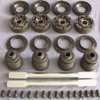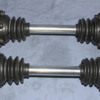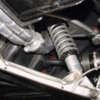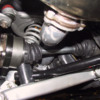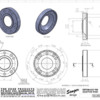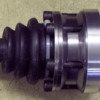Just before Christmas I blew a needle roller cup out of the left inner Uni Joint.
(I suspect it was missing the circlip but was covered over by little stainless dress up discs).
I decided to bite the bullet & make up a conversion to 930 Porsche CV joints.
Nothing new here really, its all been done before, but I thought I would photo the process so others can see what is involved.
I already had the rear suspension uprights & yokes drawn up on Solidworks from doing the taper roller bearing conversion.
This made it easier to design a flange to adapt the Pantera/ZF yoke pattern to the Porsche CV pattern as a lot of the Pantera parts I had already drawn up.
I machined up the adaptors from 125mm 4140 tensile steel so the threads had good strength.
Pictured below are the parts used, top of the parts picture are the adaptors, (zinc plated black) which have the 6 bolt pattern of the Porsche CV's & the 4 bolt pattern of the Uni yokes. They also have a good internal radius machined for axle clearance under plunge.
(Not in the picture are the M10x60 cap screws required to hold the CV’s to the adaptors).
So the M10 bolts pass through the CV's into the adaptors from one side & the 7/16" UNF bolts pass through the yokes & into the adaptor from the other side.
One side of the adaptor has a female location diameter for the 930 CV & the other side a male location diameter to suit the yoke.
Weakest point of the whole system is the four 7/16" UNF bolts, (compared to the 6 x M10 bolts through the CV's).
So I hunted around for some super tough bolts that would hopefully not fail.
I found ARP Chevy/tilton flywheel bolts to be perfect for the job, correct length of plain shank exactly 7/16" diameter, total bolt length spot on & 190,000 psi tensile rating.
Expensive, but you don’t want these bolts letting go.
Axles are race buggy 930 axles 15 5/8” long.
Being a race axle they are fully floating without CV joint shoulders, (no stress risers).
Installed picture shows the axles installed on the hoist.
So the suspension is in full droop.
CV’s clear the aftermarket sway bar bushes by around 5mm, (only after fitting countersunk screws to the Sway bar mounts, had to do this to clear the Uni’s previously).
Total weight of one axle/CV/Adaptor assembly is 8.7 kg, compared to the original Uni assembly of 8.9 kg.
So slightly lighter & I would guarantee better balanced.
It’s important to use a small diameter CV boot as with the car on its wheels the boot does not have a great deal of clearance to the inner guard hole cutout.
Finished the installation today & took the car for a good thrashing.
So far, all good, no noises, no grease leaks.
I have also included here the drawing for the CV adaptor if anyone wants to make their own.
Attachments
Original Post


